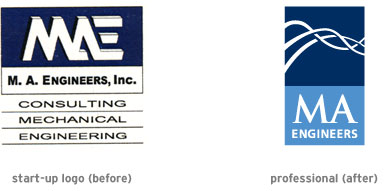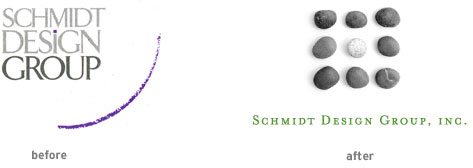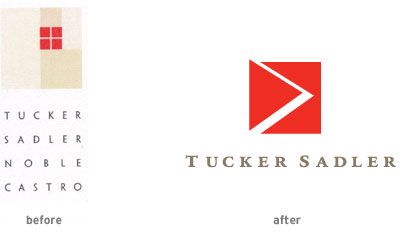
by davidlecours | Jun 29, 2011 | Branding
Have you noticed that several companies have recently updated their logos? Starbucks, GAP, Pepsi, and Comedy Central all come to mind. Should your firm update its logo? Here are four good reasons to freshen up.
1. Your Firm Has Come of Age
Congratulations! While many new businesses don’t last more than two years, yours is healthy, growing and moving from childhood into adolescence. In start-up mode, you probably didn’t invest the time, energy, and dollars to create a logo and brand identity system that represents the level of professionalism you now want to convey. As the saying goes, “what got you here, won’t get you there.” It’s time to shed the toddler haircut and baby clothes for a more grown-up look.

Perhaps your firm has reached a significant milestone. A fresh new logo can be a great way to symbolize this accomplishment. As Schmidt Design Group approached their 20 year anniversary, we worked with them to design a new logo and book that were unveiled at their 20th Anniversary Party.

2. Your Logo is Rotten (beyond its expiration date)
Everything has a life cycle. Businesses and logos go through distinct phases of conception, growth, maturity and decline. Like the myth of Narcissus, we can get overly attached to our own (brand) image. This can blind us into denial about the fact that our logo has gone into decline. Just as fashion and hairstyles become dated, your logo’s color, typography (font), and symbol may be communicating that your firm is past its prime. Even classics, like the Shell logo below, get a facelift every ten or so years.

3. A New Strategic Plan
A healthy firm grows and evolves to respond to new demands and opportunities in the marketplace. This could mean that your firm has added new services to your quiver. Or, you may be serving new markets. If the evolution of your firm is significant, you’ll want to shift the perception of prospective clients to catch up with the new you. A new logo can symbolize this shift. The first time we worked with Island Architects in 1999, it was to update their start-up logo into a more professional mark (reason #1 above). Then, in 2008, the firm made a strategic decision to communicate that they design modern homes in addition to their heritage of classical homes. A logo should be a beacon communicating where you are headed, not where you’ve been.

4. Merger, Acquisition or Ownership Change
A change in firm ownership can often inspire a new firm name and thus a new logo. Even if the firm name persists for continuity, new leadership may want a new visual symbol to represent their new era. When we began work with Tucker Sadler Noble Castro Architects, they had new owners, new Principals and a new office. Instead of continuing to add the names of Principals to the firm name, they shortened it to Tucker Sadler to reflect their founders, their web site address, and how they were referred to colloquially. We designed a new logo and brand identity system to propel the firm into a new chapter of their evolution.

Your logo is not your brand, but it is the most visible touchpoint of your brand. So, how do you know when it’s time to update your logo? The previous four scenarios are all good reasons. Or, consider hiring LecoursDesign to perform a Brand Audit. This wise investment will help you determine the strength of your logo and all your brand touchpoints.
by davidlecours | Oct 27, 2009 | Strategy
By now, you should have started creating your Marketing Plan/Budget. Here are three tips to guide you, because as you’ve probably heard, “failing to plan is planning to fail.” I know it’s tempting to simply copy and paste last year’s plan but this is a bit like driving while only looking in the rear-view mirror. Market opportunities, alliances, relationships are constantly changing so your Marketing Plan needs to evolve as well.
1. What to Include
A good Marketing Plan is a one year roadmap of how you will achieve your firm’s Strategic Plan. Here is what you should include: Budget (see below), Staffing (who will do what and by when), Timeline (prioritized sequencing of implementation), Promotional Mix (advertising, web site, social media, brochure, video PR, events, etc.). If you need help in this area, I can recommend a consultant. To help you get started, click here for a free .pdf map to help you through the process.
2. Ask for the Money
Don’t be timid in asking for a healthy budget that will allow you to effectively market your firm. There are three methods I know of to create your budget. Projection is taking last year’s budget, and based on projected growth or decline, adjust this year’s budget. Percentage is taking a straight 10″“15% of gross revenues. I recommend Goal-Based; which is taking each goal from your Strategic Plan and breaking down what it will cost to achieve that goal. You can then check this against Projection and Percentage to make sure your budget request is realistic. Your labor costs should be 50″“70% of your overall budget with promotional costs covering the remaining 30″“50%. I’m happy to provide rough estimates to help with budget requests. Is it likely that your plan might change throughout the year? Absolutely. But if you don’t ask for the money now, it will surely be designated to something else later when you really need it.
3. Implementing the Plan
Having a plan is a great first step, but implementation is what you will be measured against. First, form a core Marketing Team (not too big, but with enough Principal muscle to be influential). Marketing Plans will fail unless the talent responsible for implementation is involved in the creation of the plan. Share the Marketing Plan with everyone in the organization because marketing the firm is everyone’s business. Finally, review and measure on a regular basis (at least monthly). Be sure to share success stories internally. This demonstrates the value of marketing and builds momentum and morale.
Just doing what you’ve always done will get you what you’ve always got. So invest in your Marketing Plan to be a beacon for your best year yet. This will help to prioritize proactive and reactive opportunities and make the most of your time and money.
What Do You Think?
Is this helpful to get you started in creating your marketing plan?
Is there anything else that you include in your marketing plan?
What are some ways you motivate your team to support your marketing plan?
Similar Posts
Focus on the Bright Spots To Find Your Niche
Marketing Planning 101
by davidlecours | Aug 25, 2009 | Web & Digital

One way to measure the success of your website we is to monitor visitor’s length of stay. The longer a visitor “sticks” on your site, the greater the chance they are making an emotional connection with your brand. Using principles from the outstanding book, Made to Stick – Why Some Ideas Survive and Others Die by Dan and Chip Heath, here are three key qualities of a sticky website.
1. Simplicity
Before redesigning your website, review your strategic and marketing plans, analyzing your current site, and prioritizing what you want site visitors to do on your new site. This gives you a creative brief, or target, to compare design solutions against. Next, create a Site Map which is a clear outline of proposed content. Again, measure against brief. Now a clear navigation system can be designed which allows the visitor to easily find what they need. In a site we recently designed for KTU+A, we determined that viewing projects by market sector was a priority. So we designed the main navigation system to always show all market sectors. With the custom Content Mangagement Sytem we created for KTU+A, they are able to maintain their own site full of current content. Our goal for this site was to keep the graphic design simple so it serves as a frame, supporting their projects as the art.
2. Unexpected Personalization
To capture and hold a visitor’s attention, your site needs to surprise and delight while delivering meaningful content. With the KTU+A site, a goal was to weave their positioning of “balancing human activites with elements of nature” into the site in an enexpected way. So the visitor gets an option to choose their own background image and sound (elements of nature). This infuses the inorganic activity of using a computer with unexpected elements of nature. We created the Project List to allow visitors to sort projects in a way most meaningful to them. Visitors can sort by title, location, market sector or service with the ability to get more information on all projects and detailed information and imagery on featured projects.
3. Stories
Your brand is a story made true through personal experience. It’s critical that your site tell the story of your firm, your projects and your people in a compelling way. Invest in professional project photography and show it off at least 600 pixels wide. Here’s a great example of how impactful photography tells stories. Video is another great tool. Don’t expect your video to go “viral” on YouTube, but do expect to connect with visitors on an emotional level. Here’s a great example from NBBJ. When introducing Principals, use great photography or video, and wording that humanizes the person beyond impersonal resume bullet points. People hire people they know, so let site visitors get to know your key staff.
Your website is the new “front door” to your firm. It’s the first place prospective clients go to learn about you, or confirm what they’ve heard. Use these 3 tips to make a positive first impression “stick” in your client’s mind.
What other web site features, would you recommend to make a site sticky?
Does your website provide compelling content to make visitors stick around?
by davidlecours | Jul 10, 2009 | Content Marketing, Presentations, Strategy

For those looking to stretch their marketing budget, I can’t think of a more cost effective way to attract clients than Thought Leadership. The more a prospect can experience your thinking, writing or speaking, the more they perceive you as an expert, and the less “selling” you have to do. Content Marketing is effective for Thought Leaders because prospective clients can get to know, like and trust them in a no pressure, non-sales context. Here are some tips on how to position yourself, or Principals within your firm, as Thought Leaders.
1. Designate Ambassadors
Designate someone in your firm to be the Thought Leader for each market sector in which you seek work. For example, our client Aquatic Design Group is a market leader in designing and engineering competitive swimming pools (a market sector). They happen to have an Associate who is a former collegiate All-American swimmer. Combined with strong writing and speaking skills, he has instant credibility within this tribe.
2. Discover Where Your Audience Gathers
Ask your best clients which market specific trade publications they read and which conferences they attend. Then introduce yourself to the editors of these journals and offer your Thought Leader as a resource for journalists. Journalists constantly need credible references to interview for stories. Once the relationship is established, inquire about submitting an article or offering story leads. For national conference speaking opportunities, you’ll need to respond to a RFP a year in advance. But there are plenty of local trade organizations hungry for great speakers. Your Thought Leader doesn’t even need to speak. For example, I have put together panels and have emceed for SMPS, Pecha Kucha and USGBC events. This allows me to benefit from the halo effect of being onstage moderating the speaker panel. While it’s tempting to write or speak to your peers (fellow professional service providers), remember to focus most of your efforts where potential clients, not competitors, congregate.
3. Create a Content Ecosystem
Start with writing to develop mastery in articulating your subject matter. Then move to speaking using content you’ve written about. Give away free samples of your knowledge. Leaders demonstrate confidence by sharing their abundant expertise, not hoarding it. Tell real success stories and don’t be afraid to offer up your failures and share lessons learned. This is what makes you human, and will draw people to you. Communicate that you care about your audience’s world and challenges, and you will be invited in.
Thought Leadership requires an investment of time. This guide should help you get started. Be sure to promote your speaking or writing using the power of Social Media. Also, find multiple channels to distribute your content to maximize ROI. For example, this blog post began as an email marketing letter. It has also been broken down into a series of tweets. It could be made into a short video or podcast. Don’t overlook print to distribute your writing. You can a create a 1-page printout of a relevant post to pass out at events where you attend or present.
Whether writing or speaking, Thought Leaders are perceived as experts. Clients like to hire expertise. What are some methods you have used to demonstrate expertise? How do you promote your Thought Leadership activities? Has it ever led to new business?
by davidlecours | Feb 11, 2009 | Branding, Strategy
As Professional Service Marketers, we have the challenge of persuading prospects to purchase something that doesn’t exist. Prospects cannot “test drive” their future multi-million dollar building. Sure, you can show past projects, but that doesn’t guarantee future success. Especially if the project incorporates new technology.
The solution to this dilemma is to have a unique project delivery process that demonstrates your ability to solve problems and deliver successful projects. This communicates to the prospective client, “we don’t know all the answers to the questions your project may present. But, we have a proven process that consistently allows us to find the right answers.” By showing how you’ve helped other clients with your unique process, you put the prospect at ease, and you differentiate your firm from your competition.
1. Process Defined
Process is simply your project delivery method spanning from initial meeting through the life cycle of the building.
2. Why Brand Your Process?
There are many reasons to make your process a persuasive tool to convince clients to select your firm. First, services like Architecture, Engineering, and Contracting are simply a promise. So, we need to empathize with the scary leap of faith our clients make in entrusting us to deliver on our promise. A proven process helps to soothe client fears during the emotional sales cycle. Also, process is an opportunity to differentiate you from your competition. Process is scalable and can be implemented at firms sized from 1″“1000 to reinforce brand consistency across all branch offices. Finally, process is an asset that can live beyond the founding principals of your firm. This can add value in the event of ownership transition, merger or acquisition.
3. Develop, Articulate and Brandâ„ Your Process
Begin with listing the various steps your firm goes through to successfully complete a project. Determine all the key checkpoints for quality assurance. As you make this list, filter it through the positioning of what makes your firm unique. In other words, don’t focus on things that everyone else does. Work with a writer or brand communications firm to articulate your process in a way that is simple and compelling to a prospective client. Then brand it with a memorable name and even register it as a service mark. Our process, called The Joy of Six, is described in greater detail here. I recommend a circular process to close the loop by measuring results of the completed project. This informs an improved next project and hopefully get you re-hired.
4. Demonstrate How Your Process Yields Success
When meeting with prospective clients, don’t just show a portfolio of completed projects. Demonstrate how you reach successful results by presenting highlights of each project phase in the context of your newly branded process. Show sketches, talk about overcoming challenges, and share how intelligence gained in one project phase informs success in the next. When a prospect sees how your process delivers on past promises, it plants the seed of future success in in that prospect’s mind.
FREE .pdf of this advice







